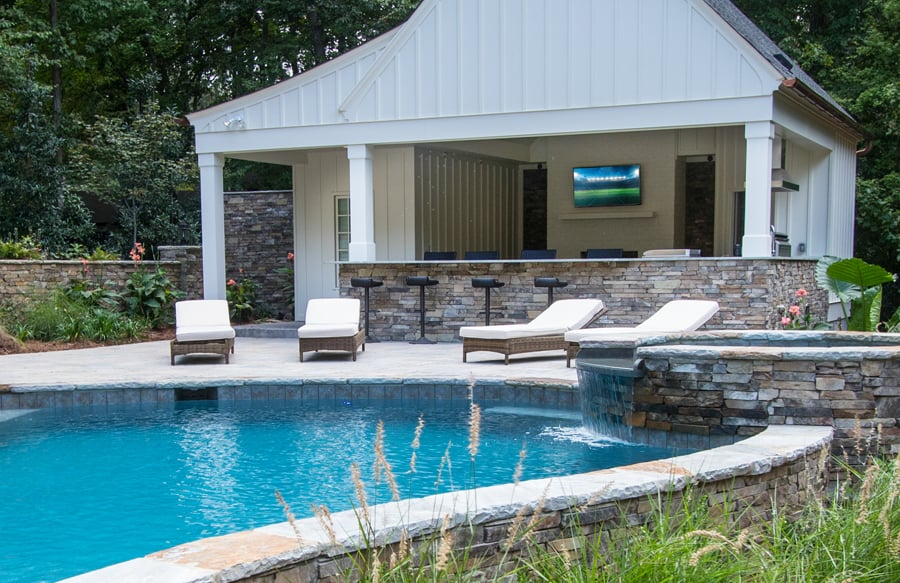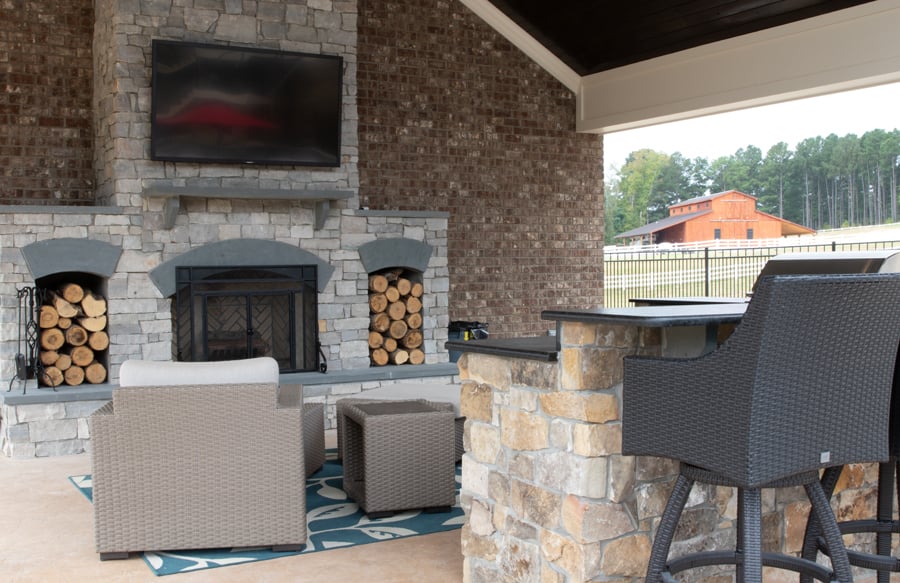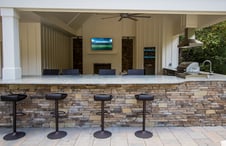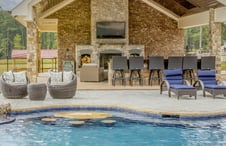—Considerations for choosing and placing waterproof TVs in poolside settings
Guest Expert: Posh UK

Setting up an outdoor TV by your swimming pool offers a smart way to enhance your outdoor space, blending indoor comfort with the beauty of the outdoors.
This amenity is the perfect backyard addition to make the most of outdoor social gatherings, family time, or personal relaxation.
However, outdoor TVs do come with some important considerations. They are exposed to diverse weather conditions, demanding specific features for durability.
That’s why choosing a waterproof TV is essential for picking one for your exterior property. These units are designed to ensure that your unit withstands the rigors of the outdoors while delivering excellent viewing quality.
Choosing the right outdoor TV is about finding the perfect mix of resilience and performance for a successful and lasting outdoor entertainment experience.
Why Include a Waterproof TV in Your Pool & Patio Area?
The entertainment value that a waterproof TV brings makes it a terrific amenity; it elevates the entertainment quotient of your outdoor space, creating an additional dimension for poolside and backyard living.
Imagine lounging in the pool or spa while watching your favorite shows, movies, or live sports on a waterproof TV by your pool. And one of these units is a total game-changer for hosting events!
Yes, it's a splurge, but this amenity adds a whole other facet of leisure to your pool and patio area.
Whether it's watching a big sports game, having a BBQ with friends, holding movie nights under the stars, or throwing a pool party, the TV can serve as a central entertainment feature.
If your pool includes convenient automation to manage its operations, you may have a way to make using the outdoor TV even easier: Depending on the system on your pool, you may be able to use it to operate your TV’s power.
Choosing the Right Outdoor TV
When it comes to enhancing your outdoor space, selecting the right model of outdoor TV is crucial.
These units are designed to protect internal components from moisture while weatherproofing guards against dust, humidity, and extreme temperatures.
Outdoor TVs differ significantly from indoor models; they come with a unique blend of technology and durability to withstand external elements and with screens that provide good viewing quality.
• Weather-Resistant Materials and Coatings
They are built with materials that resist rust, corrosion, and sun damage, and they are specifically engineered to endure cold weather and soaring temperatures, as well as dust, ultraviolet rays, humidity, and moisture.
Special coatings are applied to protect against moisture, dust, and even insects. This ensures that the unit remains functional and visually appealing, regardless of weather changes.
• IP Rating for Water and Dust Resistance
An important specification is the TV’s IP (Ingress Protection) rating.
This rating indicates the level of protection against solids (like dust) and liquids. A higher IP rating means better resistance to water and dust, making it a critical factor for outdoor TVs.
• Safety Accreditations
Safety accreditations serve as a testament to an outdoor TV's quality and suitability for external use. These certifications ensure that the model meets specific safety and performance standards.
Look for certifications that specifically mark the TV as suitable for outdoor use—particularly as a waterproof model.
These might include IP ratings, UL listings for outdoor use, or other industry-recognized standards.
These certifications not only guarantee the TV's ability to withstand outdoor conditions but also assure you of its safety and durability.
Locations: Where Should Your Outdoor TV Go?

The placement of your outdoor monitor greatly affects its usability and performance. Direct, continuous sunlight can lead to overheating and screen glare, compromising the viewing experience.
So, what are some strategies to mitigate the impacts of solar rays and heat?
So, what are some strategies to mitigate the impacts of solar rays and heat?
It’s advisable to mount your TV in a location that avoids direct UV onslaught, especially during peak viewing hours. This might involve choosing a shaded area or a strategic angle that minimizes sun exposure.
For areas with unavoidable sunlight, opt for TVs with high brightness levels and anti-glare screens. These features significantly improve visibility and comfort, even under strong sunlight.

Popular Options
If you want the screen poolside, consider strategically placing it in a sightline where you can still enjoy it as you lounge in the water.
For example, position the TV so you can easily view it while relaxing in the spa, sitting on the pool loveseat, or lying on the tanning ledge. And consider if you will be able to hear it as well.
Among the most popular spots for an outdoor TV is tucked into a structure covered by a hardtop roof, such as a swim-up bar, poolside kitchen, or “outdoor living room.” (In big-ticket projects, a TV can even go inside an elaborate swimming pool grotto.)
This kind of setting makes it easy for users to watch and listen to the TV. In addition, the structure provides extra protection from the sun’s glare, ambient heat or cold, and precipitation.
If the structure has any full or partial walls, it may buffer some of the sounds coming from adjacent activities, such as splashing in the pool.
In regions with mild climates, some homeowners go another route: If their TV will live in one of these well-covered structures, they opt to buy a regular indoor TV.
They have made the decision to pay less upfront for a regular unit—vs. a higher-cost outdoor model—and buy a new one every few years to replace the one being used outside.
Protecting Your Outdoor TV


Waterproof TVs are engineered to withstand the challenges posed by poolside and outdoor conditions, such as splashes and humidity.
These units will operate under conditions that would compromise a regular TV, ensuring that your investment is protected and continues to perform for years to come.
However, you will also need to protect your device if you want to watch TV by the pool or by a spa. Here are some of our tips.
Guarding against moisture
Outdoor TVs need safeguarding against moisture and adverse weather conditions. This protection is crucial to maintain the unit's functionality and lifespan.
Sealing and covering
Seal all cable connections to prevent water ingress.
Use weatherproof covers or enclosures when the TV is not in use. These covers shield the TV from rain, snow, and even dust or debris. (If the TV is mounted under a protective roof, such as inside an outdoor kitchen, the cover may not be needed.)

Additional protection from the elements
If the unit is not inside one of the structures described earlier, consider installing a small awning or canopy over your outdoor TV.
These structures provide additional protection from rain and can also help reduce sun glare during certain times of the day.
You also want to consider protecting the unit against solar glare that can significantly degrade your viewing experience. Addressing this is important to ensure your outdoor TV is enjoyable to watch at all times of the day.
There are anti-glare screens available that can be fitted to your outdoor TV (a UV light protective layer).
Additionally, positioning the TV in a way that minimizes direct sun exposure, especially during peak hours, can help reduce glare.


The Takeaways
In conclusion, a successful outdoor TV setup involves choosing a durable, weatherproof TV, installing it with a robust mount in a well-considered location, and ensuring it's protected from weather and theft.
Regular maintenance is key for longevity. Embrace this addition to your outdoor space, as it promises to elevate your entertainment experience, making gatherings, relaxation, and family time more enjoyable under the open sky.




.jpg?width=1490&name=rock-waterfall-slide-pool%20(1).jpg)

